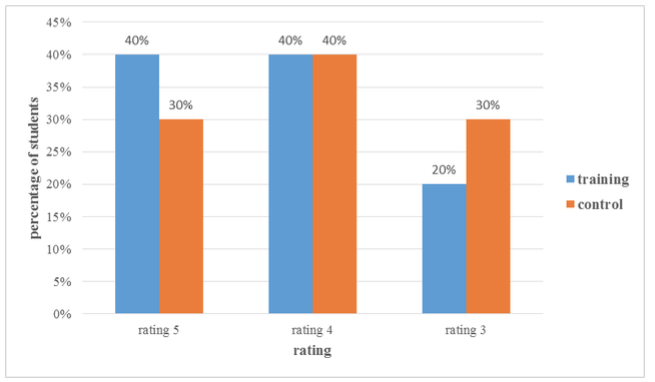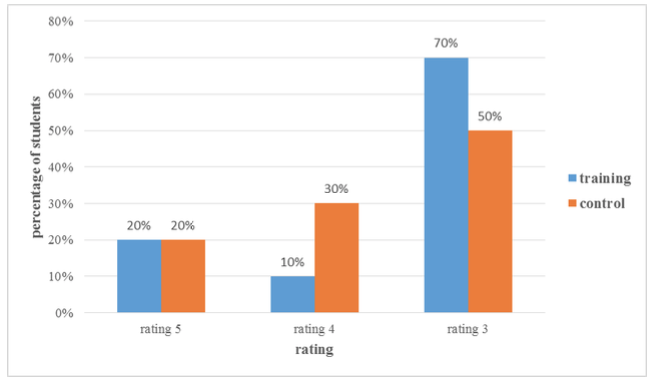

 Vol. 40 (Number 8) Year 2019. Page 6
Vol. 40 (Number 8) Year 2019. Page 6
SEVBITOV Andrey V. 1; KUZNETSOVA Maria Yu. 2; DAVIDIANTS Alla A. 3; BORISOV Vitaliy V. 4; DOROFEEV Aleksey E. 5; TIMOSHIN Anton V. 6
Received: 10/10/2018 • Approved: 27/01/2019 • Published 06/03/2019
ABSTRACT: The article presents the study results of the training of stomatological faculty students for manual skills of the preparation of the first class cavity by Black on simulators with various levels of realism. Three groups of 10 students each were trained in three different methods: teaching only on the phantom, training only on the simulator, training on both the phantom and the simulator. As a result of the study, it has been established that training on phantoms with different levels of realism is complex, so the authors consider various combinations of exercises aimed at obtaining the best result. The proposed concept of teaching for the preparation skill can be the basis for the development of a standard curriculum in higher education. |
RESUMEN: El artículo presenta los resultados del estudio de la capacitación de profesores de estomatología para las habilidades manuales de preparación de la primera clase de cavidades por Black en simuladores con varios niveles de realismo. Tres grupos de 10 estudiantes fueron entrenados en tres métodos diferentes: enseñando solo en el fantasma, entrenando solo en el simulador, entrenando tanto en el fantasma como en el simulador. Como resultado del estudio, se ha establecido que la formación de fantasmas con diferentes niveles de realismo es compleja, por lo que los autores consideran varias combinaciones de ejercicios para obtener el mejor resultado. El concepto propuesto de enseñanza para la preparación de un plan de estudios estándar para la educación superior. |
The use of simulation technologies in medicine, and especially in dentistry, spreads extremely quickly. The reason for their increased demand is the need for quality medical care and the need quickly learning the manual skills of students. Creation and implementation of a new material and technical base, development of new algorithms and standards of treatment significantly increase the effectiveness of dental care (1,2,3,4,5).
At present there are simulators of seven different levels of realism:
1) visual (anatomical model or computer textbook);
2) tactile (phantom, simulator of manual skill);
3) reactive (phantom, dummy with electronic controller, economic simulator);
4) automated (dummy with computer controller, video system of surgical training);
5) hardware (addition of a dummy or simulator with medical equipment);
6) interactive (the robot-simulator of the patient of the highest class, the virtual simulator with the reverse connection);
7) integrated (a system of interacting simulators and robots) (6,7,8,9).
As part of pre-clinical training, dentists work in phantom units, practicing many of the skills that are needed to further patients treat. Various phantom settings allow you to master manual skills to students of stomatological faculties with different learning curve. Learning the manual skill of preparation on phantom units is quite a long process. Thus, the development of new algorithms for teaching the manual skill of the preparation is relevant for today (10,11,12,13).
A study of the effectiveness of teaching the skill of preparation the first class cavities in the Black on phantom installations with different levels of realism (14,15).
30 second-year students of the stomatological faculty aged 17-19 were selected for the study. The main criterion for selection was the absence of previous preparation experience. Then the students were divided into 3 groups. In the first group of "C" (virtual simulator), the training of the preparation skill was carried out only on the simulator with different cavity shapes. In the second group, "C + F" (simulator and phantom), the training began on a simulator (dissimilar also in various cavities), and then on plastic plates and phantom units. In the third group "F" students were trained only on phantom installations and plastic plates. At the training stage all trainees performed a number of similar tasks: preparation of cavities of various shapes and depths.
The control stage for all three groups is the preparation of teeth according to the first class according to Black on phantom teeth.
Evaluation criteria: they were exhibited on a 3-point system. 1 point is satisfactory (errors in preparation of cavity cavities and depth of cavity more than 1 mm), 2 points are good (errors in preparation of cavity boundaries and depth of cavity less than 1 mm), 3 points - excellent (no outflows beyond the cavity in depth on the preparation boundary).
Also the time needed to teach the skill of preparation in each group was recorded. Then, in each group, students who received an assessment of 3 points were allocated and determined the time spent on manual skills training on "excellent" in each group.
At the training stage in the "C" group 55% of students made the preparation for the rating "excellent", 36% for the rating “good”, "9%" for the rating "satisfactory".
According to the results of the control preparation in the "C" group 82% of the students scored "excellent", "satisfactory" - 18%. Rating of "good" at the stage of the control preparation was absent. Thus, some students in transition from a phantom of one level of realism to another require additional time for adaptation (fig. 1).
Figure 1
Results of training and control preparations of group "C" (simulator)

In the "C + F" group (simulator + phantom) 40% of the students scored "excellent" at the training stage, "good" rating has 40% of students, "satisfactory" rating - 20% of the students.
According to the results of the control preparation in the same group of "C + F" 30% of the students completed the work with rating "excellent", with "good" - 40% of the students, "satisfactory" - 30%. And in this group there is an increase of the rating "satisfactory" when moving from one level of realism to another (fig. 2).
Figure 2
Results of training and control preparations of the group "C + F" (simulator = phantom)

At the training stage in the group "F" (phantom) 20% of students were assessed for the "excellent" rating, 10% for the rating "good", 70% for the rating "satisfactory".
Based on the results of the control preparation in the "F" group, 20% of the students completed the work with rating “excellent”, "good" - 30% and "satisfactory" - 50% (fig. 3).
Figure 3
the results of the training and control preparations of the "F" group (phantom)

The mastering of the manual skill on the "excellent" grade in group "C" on the average took 25 minutes, in the group "C + F" - 50 minutes, and in the group "F" - 3 hours.
As a result of the study, it was revealed that for the mastering of the manual skill of the preparation of the first class cavities according to Black, the smallest learning curve is on the virtual tactile level simulator. However, students need time to adapt the transition to the actual preparation conditions when moving from a virtual simulator tactile level of realism to a phantom. Therefore, we proposed a new training scheme for the preparation skill: the first stage - a phantom tactile level of realism, then - a virtual simulator to reduce the learning curve of the acquired skill and transition to real preparation conditions.
1. Sevbitov A.V., Platonova V.V., Mironov S.N., Dorofeev A.E., Pustokhina I.G. Experimental substantiation of the bactericidal effect of sodium hypochlorite on the microflora of a purulent wound with odontogenic phlegmons of the face and neck. Indo American Journal of Pharmaceutical Sciences. 2018. 5(3), 1635-1637.
2. Utyuzh A.S., Yumashev A.V., Mikhailova M.V. Spectrographic analysis of titanium alloys in prosthetic dentistry. Journal of Global Pharma Technology. 2016. Т. 8. № 12. С. 7-11.
3. Ershov K.A., Sevbitov A.V., Dorofeev A.E., Pustokhina I.G. Evaluation of elderly patients adaptation to removable dentures. Indo American Journal of Pharmaceutical Sciences. 2018. 5(3), 1638-1641.
4. Kuznetsova M, Nevdakh AS, Platonova VV, Sevbitov AV, Dorofeev AE. Evaluation of effectiveness of a preparation on the basis of phytoecdysteroids for treatment of traumatic injuries of oral mucosa in orthodontic patients. Int J Green Pharm 2018;12:297-300.
5. Sevbitov A.V., Vasilev Yu.L., Kanukoeva E.Yu., Drobot G.V., Platonova V.V., Dorofeev A.E. Analysis of the perception of pain of elderly patients duringsurgical dental appointment. International Dental Journal. 2017. 67 (S1), 64.
6. Yumashev A.V., Gorobets T.N., Admakin O.I., Kuzminov G.G., Nefedova I.V. Key aspects of adaptation syndrome development and anti-stress effect of mesodiencephalic modulation. Indian Journal of Science and Technology. 2016. Т. 9. № 19. С. 93911.
7. Timoshin AV, Sevbitov AV, Drobot GV, Yumashev AV, Timoshina MD. Use of bioresorbable plates on the basis of collagen and digestase for treatment of diseases of oral mucosa (review of clinical cases). Int J Green Pharm 2018;12:290-6.
8. Yumashev A.V., Utyuzh A.S., Volchkova I.R., Mikhailova M.V., Kristal E.A. The influence of mesodiencephalic modulation on the course of postoperative period and osseointegration quality in case of intraosseus dental implantation. Indian Journal of Science and Technology. 2016. Т. 9. № 42. С. 104307.
9. Timoshin AV, Sevbitov AV, Ergesheva EV, Boichuk AV, Sevbitova MA. Experience of treatment of aphthous lesions of oral mucosa by preparations on the basis of collagen and digestase. Asian J Pharm 2018;12:284-7.
10. Borisov V.V. Using ultraviolet containers for storage and transportation of mouthguards Indo American Journal of Pharmaceutical Sciences. 2018. 5(2), 1322-1326.
11. Evstratenko VV, Sevbitov AV, Platonova VV, Selifanova EI, Dorofeev AE. Distinctive features of crystallization of mixed saliva in patients taking heroin and methadone. Clin Lab Diagn 2018;63:223-7.
12. Akhmetshin E.M., Morozov I.V., Pavlyuk A.V., Yumashev A.V., Yumasheva N.A., Gubarkov S.V. Motivation of personnel in an innovative business climate. European Research Studies Journal. 2018. Т. 21. № 1. С. 352-361.
13. Platonova VV, Sevbitov AV, Shakaryants AA, Dorofeev AE. Experimental and clinical substantiation of treatment of patients having odontogenous phlegmons of maxillofacial region with use of preparation dalargin in complex therapy. Clin Lab Diagn 2018;63:293-6.
14. Borisov V.V., Sevbitov A.V., Poloneichik N.M., Voloshina I.M. Use of vector patterns for manufacturing of individual protective dental splints by method of thermoforming. Indo American Journal of Pharmaceutical Sciences. 2018. 5(1), 697-699.
15. Sevbitov A.V., Timoshin A.V., Ergesheva E.V. Analysis of effectiveness of use of bioresorbable plates on the basis of collagen and digestase for treatment of inflammatory diseases of parodentium in adolescents. Indo American Journal of Pharmaceutical Sciences. 2018. Т. 5. № 1. С. 1-5.
1. D.Sc. in Medicine, Professor, Head of the Department of propaedeutics of dental diseases, Sechenov University, Moscow, Russian Federation. E-mail: avsevbitov@mail.ru
2. Ph.D. in Medicine, Associate Professor of the Department of propaedeutics of dental diseases, Sechenov University, Moscow, Russian Federation. E-mail: mary-smith@yandex.ru
3. Ph.D. in Medicine, Associate Professor of the Department of propaedeutics of dental diseases, Sechenov University, Moscow, Russian Federation. E-mail: allshakar@yandex.ru
4. Ph.D. in Medicine, Associate Professor of the Department of propaedeutics of dental diseases, Sechenov University, Moscow, Russian Federation. E-mail: karapeta@yandex.ru
5. Ph.D. in Medicine, Assistant of the Department of propaedeutics of dental diseases, Sechenov University, Moscow, Russian Federation. E-mail: aedorofeev88@gmail.com
6. Assistant of the Department of propaedeutics of dental diseases, Sechenov University, Moscow, Russian Federation. E-mail: avtimosin91@mail.ru